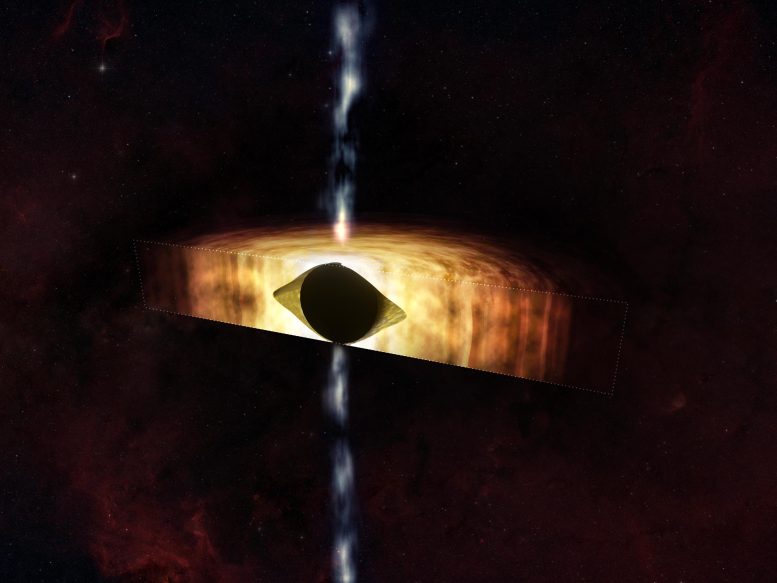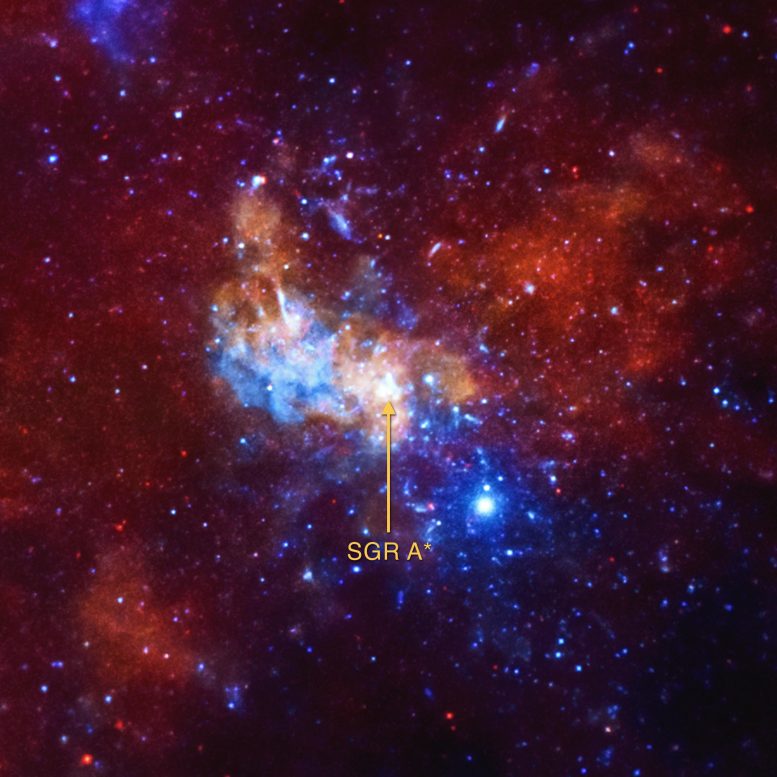
This artist’s illustration shows a cross-section of the supermassive black hole and surrounding material in the center of our galaxy. The black sphere in the center represents the event horizon of the black hole, the point of no return from which nothing, not even light, can escape. Looking at the spinning black hole from the side, as depicted in this illustration, the surrounding spacetime is shaped like an American football. The yellow-orange material to either side represents gas swirling around the black hole. This material inevitably plunges towards the black hole and crosses the event horizon once it falls inside the football shape. The area inside the football shape but outside the event horizon is therefore depicted as a cavity. The blue blobs show jets firing away from the poles of the spinning black hole. Credit: NASA/CXC/M.Weiss
- A new study may help settle the question of how rapidly the Milky Way’s supermassive black hole is spinning.
- The black hole, known as Sagittarius A* (Sgr A*), contains about 4 million times the mass of the Sun.
- Using NASA’s Chandra X-ray Observatory and NSF’s Very Large Array, this study found Sgr A* is spinning very rapidly.
- This high spin is warping the spacetime around Sgr A* so it appears to have the shape of an American football.
This artist’s illustration depicts the findings of a new study about the supermassive black hole at the center of our galaxy called Sagittarius A* (abbreviated as Sgr A*). This result found that Sgr A* is spinning so quickly that it is warping spacetime — that is, time and the three dimensions of space — so that it can look more like a football.
These results were made with NASA’s Chandra X-ray Observatory and the NSF’s Karl G. Jansky Very Large Array (VLA). A team of researchers applied a new method that uses X-ray and radio data to determine how quickly Sgr A* is spinning based on how material is flowing towards and away from the black hole. They found Sgr A* is spinning with an angular velocity that is about 60% of the maximum possible value, and with an angular momentum of about 90% of the maximum possible value.
Black holes have two fundamental properties: their mass (how much they weigh) and their spin (how quickly they rotate). Determining either of these two values tells scientists a great deal about any black hole and how it behaves. In the past, astronomers made several other estimates of Sgr A*’s rotation speed using different techniques, with results ranging from Sgr A* not spinning at all to it spinning at almost the maximum rate.
The new study suggests that Sgr A* is, in fact, spinning very rapidly, which causes the spacetime around it to be squashed down. The illustration shows a cross-section of Sgr A* and material swirling around it in a disk. The black sphere in the center represents the so-called event horizon of the black hole, the point of no return from which nothing, not even light, can escape.
Looking at the spinning black hole from the side, as depicted in this illustration, the surrounding spacetime is shaped like a football. The faster the spin the flatter the football.
The yellow-orange material to either side represents gas swirling around Sgr A*. This material inevitably plunges towards the black hole and crosses the event horizon once it falls inside the football shape. The area inside the football shape but outside the event horizon is therefore depicted as a cavity. The blue blobs show jets firing away from the poles of the spinning black hole. Looking down on the black hole from the top, along the barrel of the jet, spacetime is a circular shape.

Chandra X-ray image of Sagittarius A* and the surrounding region. Credit: NASA/CXC/Univ. of Wisconsin/Y.Bai, et al.
A black hole’s spin can act as an important source of energy. Spinning supermassive black holes produce collimated outflows such as jets when their spin energy is extracted, which requires that there is at least some matter in the vicinity of the black hole. Because of limited fuel around Sgr A*, this black hole has been relatively quiet in recent millennia with relatively weak jets. This work, however, shows that this could change if the amount of material in the vicinity of Sgr A* increases.
To determine the spin of Sgr A*, the authors used an empirically based technique referred to as the “outflow method” that details the relationship between the spin of the black hole and its mass, the properties of the matter near the black hole, and the outflow properties. The collimated outflow produces the radio waves, while the disk of gas surrounding the black hole is responsible for the X-ray emission. Using this method, the researchers combined data from Chandra and the VLA with an independent estimate of the black hole’s mass from other telescopes to constrain the black hole’s spin.
The paper describing these results led by Ruth Daly (Penn State University) is published in the January 2024 issue of the Monthly Notices of the Royal Astronomical Society.
Reference: “New black hole spin values for Sagittarius A* obtained with the outflow method” by Ruth A Daly, Megan Donahue, Christopher P O’Dea, Biny Sebastian, Daryl Haggard and Anan Lu, 21 October 2023, Monthly Notices of the Royal Astronomical Society.
DOI: 10.1093/mnras/stad3228
The other authors are Biny Sebastian (University of Manitoba, Canada), Megan Donahue (Michigan State University), Christopher O’Dea (University of Manitoba), Daryl Haggard (McGill University) and Anan Lu (McGill University).
NASA’s Marshall Space Flight Center manages the Chandra program. The Smithsonian Astrophysical Observatory’s Chandra X-ray Center controls science operations from Cambridge, Massachusetts, and flight operations from Burlington, Massachusetts.









Hello, i hope you don’t mind my question on black holes, i enjoyed your report recenrty speakin . . .
Megnetic fields are getting a bit more iterest of late, do black hole create a large manetic field or do they retain that energy . . .
If they have a magnetic field outside of the event horizion, why isn’t the electronatic field affected by the most awsome material enery we know of . . .
Doubt it a very easy question to quantify without further data . . .
All the best of wishes,
jon.
In my lay model of the universe space just is and time just isn’t; no such thing as space-time, dark matter or dark energy. Since 2012 I’ve been demonstrating that gravity is intensified in rotating objects, with spinning wheels (e.g., https://odysee.com/@charlesgshaver:d/1Gravity:8). That SGR A is spinning rapidly and the configuration of the objects in relative close proximity is similar in shape to an American football from the side comes as no surprise to me, in consideration of the direction of its rotation and the distribution of its mass and its pattern of intensified gravity. From the top or bottom that volume of space would probably resemble a center-thick disk.
Memo 2402110325
The argument that the black hole’s bending of time and space is due to the black hole rugby ball sensor.4d type ‘may be due to the surface of the nuclear center object’ is based on the material created by alternating oscillations of the cross-time difference qixer: quxer from the unstable double axis of dark energy. Huh.
Furthermore, the unstable energy may have produced waves with varying curvature of spacetime as a result of the combination of 2qvixer.msbase.linear on an unknown qms scale. Uh-huh.
A more surprising assumption is that numerous black holes could have formed voids through spacetime holes. As if the black hole disappears from the hole, eventually a void ems is formed and a filament spacetime lattice is formed. This is ems.void.spacetime(). Huh.
Black holes move to other voids and only void1~void2 disappears, and numerous ems.void interiors represent the distribution of black hole zz’line and star smolas. Huh.
Nice article about our spinning black hole but they neglected to indicate how fast its spinning. Any reason for that?
The authors don’t seem to understand the shape of an (American) football! If they want to use a sports object, they should say the spacetime is warped into a discus. Either that, or it is an international football that has lost air and has flattened! =;-D